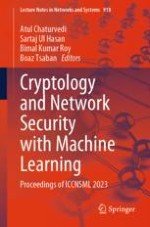2024 | OriginalPaper | Buchkapitel
Supervised Learning Approaches for Deceit Identification: Exploring EEG as a Non-invasive Technique
verfasst von : Subhag Sharma, Manoj Kumar Gupta
Erschienen in: Cryptology and Network Security with Machine Learning
Verlag: Springer Nature Singapore
Aktivieren Sie unsere intelligente Suche, um passende Fachinhalte oder Patente zu finden.
Wählen Sie Textabschnitte aus um mit Künstlicher Intelligenz passenden Patente zu finden. powered by
Markieren Sie Textabschnitte, um KI-gestützt weitere passende Inhalte zu finden. powered by
